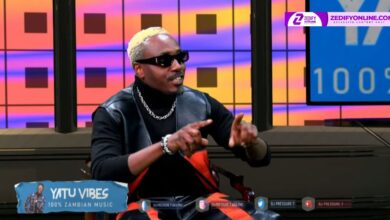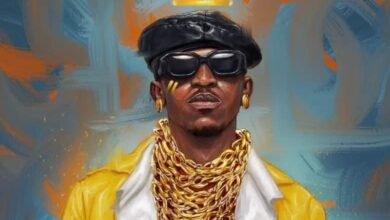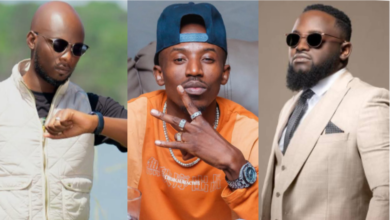YO MAPS IS LEADING THE PACK SAYS ROBERTO ON BBC – THIS IS AFRICA’S SPECIAL EPISODE “ZAMBIA KU CHALO” PART ONE

PLEASE NOTE: This article is an adaptation from BBC Sounds’ This Is Africa hosted by DJ Edu for a special edition focused on Zambia tittled “Zambia Ku Chalo”part one.

Edwin Ochieno popularly known as DJ Edu is a host of BBC 1Xtra’s AfroSounds show which showcases talent from across Africa featuring prominent names in the music industry including Sarkodie, Nasty C, Davido, Diamond among others. On this special episode titled “Zambia Ku Chalo – part one,” DJ Edu took time to explore Zambian music.
The special edition features three episodes, and on this first episode, the DJ arrived in Zambia, and top Zambian artist Roberto was picking him up from Kenneth Kaunda International Airport.
The episode started with this intro from DJ Edu as he arrived at the airport in Zambia, “Yes! good people, this is DJ Edu, just landed in the LSK, about to meet my brother from another mother, Mr. Roberto!” DJ Edu open this special edition’s part one.
He continued, “Roberto is a Zambian singer, songwriter, producer and radio host back in the days and he is one of the people who has been letting me know when there is something exciting happening in the Zambian music scene.”
Roberto and DJ Edu exchanged plesentaries at the airport, as they were happy to meet each other. DJ Edu joked about him coming to Zambia first before Roberto went to visit him in the United Kingdom.
After the plesentaries, DJ Edu continued, “Myself and the TIA(This Is Africa) team has been on the road, getting closer to the music and musicians that are what ‘This Is Africa’ is all about. The African continent is huge, and there is so much out there than just Afrobeats and Amapiano. Zambia is a good example of this musical diversity. It’s a country with 73 different languages and subcultures, so does it make sense at all to talk about a Zambian sound? Could Zambia, aka the real Africa, give us the next big African musical genre? Join me over the next three editions of This Is Africa when I will be having fun trying to find out.”
Roberto and DJ Edu continued their cordial exchange as they got to the car. The two went on to have a discussion on the Zambia sound and music.
The conversation started with DJ Edu asking if Roberto listens to his music a lot as his song ‘Bestie’ was playing the moment they entered his car,”So Roberto, do you listen to your own music alot?”
Roberto responded, “I’m listening to this one because this is the song that we are releasing this Thursday, so we’re just debating and discussing one or two thing we want do as we release it, yeah! Haha, so the minute I stepped into the car, it automatically started playing (laughs). ”
Whilst in the car, DJ Edu thanked Roberto for picking him at the airport, then the DJ went ahead to praise Lusaka outlook to which Roberto respondend sarcastically saying he should hold on to his praise for when the sun came up.
The conversation then continued as DJ Edu asked about the Zambian sound. “What is a typical Zambian song sound like, what is the sound?”
Roberto responded,”It is almost like, not really like kizomba as per say, but it’s like a raggaeton drum pattern type of sound, and then now with the introduction of the log drum because of Amapiano, you find that there’s a fusion of the raggaeton drum pattern and then base line is played Amapiano, the cord progression is what you would term your RnB/POP sound. So it’s like a fusion of different sounds, yeah. So, Zambia, Malawi, we almost like share similar sounds because our languages are very similar, yeah.”
DJ Edu, with curiosity to know the Zambian music industry, sound further queried,” Are there any other local genres like Kalindula? Are those genres popular? And if there’s any other you can let me know about?”
In response, singer Roberto said,”So Kalindula is like our local sound, and Kalindula was derived from Rumba and a bit of Funk or Disco from back in the days, and then there was also Rock. So it’s like a fusion of different sounds at the end of the day, but of course it’s identified as the typical Zambian sound, yeah, so right now I wouldn’t say that there’s much of artists getting to produce Kalindula sound as per say but they just usually fuse in elements from what one would perceive as Kalindula sound.”
Satisfied with his well articulated response, DJ Edu went ahead to find out who is the top Zambian artist at the moment. “And who are some of the big artists at the moment in the country?” He asked.
To which Roberto responded, not seemingly willing to mention names, but starting with some humour, he mentioned himself first and went on to reveal several names in the industry. Here is what he said, “Listen, you are putting me in a tough spot because I am gonna say me, but hey, anyways…(laughs)”
DJ Edu cuts in,”Yeah man, come on, you are the first person we are speaking to so obviously.”
Roberto continued, “For the purpose of diplomacy, I would say (laughs)right now I would definitely say Yo Maps has been leading the pack with a set of new artists that have emerged in the country. If you speak of female artists, we have Towela. Towela is a 100% RnB/Afropop artist. And when it comes to rap, the female side, there’s Xaven, there’s Bombshell, there’s Cleo Ice Queen, and then there’s also a new sound that has emerged from an area called Copperbelt Province, here in Zambia. So when you listen to the female rappers from the Copperbelt, you can literally tell the difference in just the sound.”
The singer further continued his listing, “Mampi as well has had a very good year, and then ah, the male rappers, there’s Triple M, Vinchezo has come on the scene as well. These are like new artists who have been doing exceptionally well for the past two, three years. Dizmo and Jae Cash, these two artists are pretty much like the biggest artists on the ground, here in Lusaka. So when you go to the mass density areas, you’ll probably hear more of Jae Cash and Dizmo but not forgetting that Slapdee and Macky 2 are still considered icons. And by the way, there is an artist called Y Celeb who has been (laughs) yey! Y Celeb has been amazing, this man, I do not know what time he sleeps because it’s almost like he’s putting out music every single week.”
Roberto and DJ Edu continued their conversation as he schooled the BBC 1Xtra’s AfroSounds Show host DJ Edu on areas around Lusaka. The two were driving from the airport. The program then continued with DJ Edu shouting out his show TIA as he notified that he would be visiting Grandaddy’s and talk to the artists that Roberto mentioned.
DJ EDU AT GRANDADDY’S WITH DJ TWIZZY
In his efforts to understand the Zambian sound and what kind of music is played the most in Zambia clubs, DJ Edu headed to the one place every Zambian wants to be when the sun sets – Grandaddy’s. While at Grandaddy’s, DJ Edu met with the one and only DJ Twizzy. DJ Edu first impression of Gradaddy’s was that it was filled with young people.
“So my brother, how’s the scene in the club?” DJ Edu asked DJ Twizzy after some friendly greetings.
DJ Twizzy responded, “It is very beautiful. There are people who like Dancehall, amapiano, Zambian music, Afrobeats, house music, so it’s a mix vibe of everything”
DJ Edu further asked, “What is the genre that you find people love the most here?” To which DJ Twizzy responded, “Can I be honest, I think amapiano is the most growing genre and now a lot of people are now adapted to the new genre which is amapiano, but I think most of the people love Afrobeats.”
“And do you think they prefer Zambian music to international music?” DJ Edu asked.
DJ Twizzy, “A lot of people will be listening to Zambian music. At some point, they wanna listen to some international music, so it’s mixed up.”
DJ Edu,” And in other clubs, do people play the same or similar?”
DJ Twizzy, “It depends on where you are going, there are places where they will play, maybe 100% or 70% Zambian music and there are other places that will play maybe 50% of Zambian music, there are other places that will play maybe 30% Zambian music, it depends on where you are going.”
“Thank you so much, my brother DJ Twizzy, for holding it down here in Lusaka, Zambia. I’m DJ Edu, and right now, I’m letting my brother take over the decks to bring to you this week’s 10 in 10 mix, which is full Zambian vibes. Take it away, DJ Twizzy” – DJ Edu
DJ Twizzy went ahead and played a mix of Zambian songs. The ten songs included the following:
● T Low’s Kale Bwangu
● JC Kalinks’ Akale
● Vinchezo’s Cheers To The Good Times featuring Bobby East
● T Sean’s Tabaafwa featuring JC Kalinks
● Yo Maps’ Ex Wamunandi
● Ndine Emma’s Run featuring Chanda na Kay
● F Jay’s Ma Feelings
● Triple M’s Follow featuring Driemo
● JC Kalinks’ Ichibyongo
● Macky 2’s Ni Natural featuring Yo Maps
DJ EDU MEETS PRODUCER AND RAPPER MAG 44 AT HIS HOME STUDIO
The DJ’s next stop was at celebrated producer and rapper Mag 44’s home. The two shared some greetings before he went right into the questions.
DJ Edu started by asking Mag 44 to introduce himself as he said, “For those that do not know, who are you?”
Mag 44 responded, “So I am a music producer, and I’m an artist but mainly producing, but I’m also a rapper.”
DJ Edu threw in some humour as he asked, “And what name do you go by? You know you people always have very funky names(laughs).”
To which the rapper and producer responded, “Yeah, yeah, mine is not so funky. It’s Mag 44. So my real name is Magnus, so then, of course, there’s an apostrophe on Mag 44, so it was easier to just call myself Mag 44 in the end.”
DJ Edu, looking at Mag 44’s trophies collection, proceeded by asking, “And I see you’ve been shooting because there’s a lot of plaques here, explain this man.”
Mag 44, in his response, being humble, responded, “Few awards here, I got this, a RCV(Radio Christian Voice) award, best producer. I know people with more awards, but I’m happy with what I got, yeah (laughs).”
He continued by mentioning the artists he worked with and how they helped him gain a good reputation as a producer, “The first artist I ever recorded was Tio Nason. He’s still an artist now. The second artist was Able Chungu, and then I think the one who really brought me out to the mainstream was Pompi. Then, from there, I got many other opportunities. I’ve produced some guys like Chef 187, also his brother Macky 2, Slapdee, and then most recently I have been working with the amazing Sampa The Great who has made the production side of me to just, even higher level, of course through sampa we’ve worked with Angelique Kidjo. Through another artist, Truth, who is a Grammy nominated artist, I’ve done worked with artists like Limoblaze and Travis Greene.”
Amazed at his work, DJ Edu responded, “Haha, I’ve been standing amidst greatness.” While Mag 44, who seemed flattered, responded in affirmation, “Of course, you are (laughs).”
Mag 44 then proceeded to show DJ Edu the studio where Sampa The Great’s “So Above, So Below” album was recorded.
DJ Edu then proceeded to ask his last question, “So let’s talk about the state of music industry because you sit in a very unique place where you make the music.”
Mag 44 responded, “I’d say we’re like from being teenagers into being young adults. You know there were sounds like Kalindula and Zamrock right, which were phased out for many reasons. We had to start over, so in the late 90s, a record label called Mondo Music could have sort like kick-started everything. ”
He continued, “So we had guys like daddy Zemus and Mainza and all these different artists who were now trying to define what Zambian music, and 20 years later, it’s grown a whole lot. Our sound has long been defined by what the US, what Nigeria, South Africa is doing, and what I think, what is happening is that we are slowly starting to build something that is purely Zambian. ”
He further continued, “Even if we do things like Hip-Hop, we are saying OK fine how do we fuse Hip-Hop with Kalindula, with Zamrock, you know fine, we’ve got Afrobeat how do we fuse that with the Zambian sound. But I think, the place that is doing it very well is the Copperbelt, a lot of the artists from the Copperbelt are really creating a sound that defines Zambian music and not only the sound but even just the culture, you know the way people live there and just the vibe on the Copperbelt is now coming through in the music and creating something that is totally new that the world has never seen. The Copperbelt has created its own sound, which is derived from like traditional bemba sounds. So they use the traditional drums, there’s this (imitates a sound), so that’s like(A Chanda na Kay song plays)”
DJ Edu, “So is there a song, an example of a song?”
Mag 44 responded, “I love that sound. So what they did is, they got that traditional sound and fused it with a harder kick, edo8, and sort of having Afrobeat drum line but adding that shaker, stick bongo sound that would predominantly be heard from the bembas.”
The episode from this edition ended, and DJ Edu’s next mission was on the Copperbelt where he was going to meet up with Chanda na Kay and the Kopala Queen, Xaven. Read part two of this edition by clicking HERE.





